Tourist in Romania (english)
A trip on the Mocanita steam train on the Vaser Valley’s gorge in the Maramuresului Mts. looks like a getaway through another time portal and is one of the attractions for the Romanian and foreign tourists who come to Maramures.

Photographies by Gabriel PETRESCU / AGERPRES ARCHIVE
Regardless of their schedule, tourists try to get to the Vaser Valley’s gorge to enjoy for a few hours the steam engine puffing hard to climb up the several tens of kilometres on the mountain, accompanied all this time by the well-known Vaser Valley.
The tourism with the Mocanita train on the Vaser Valley has come to be promoted in the 90s, once with the re-opening of the access to one of the most interesting destinations of the county. The steam train and the trolleys as well do transport their passengers on the narrow gauge line which was built by the Germans and the Austrian Zipsers (settlers in the Spi? region were known as Zipser Sachsen or “Scepusian Saxons”) in the First World War’s period who have colonized the Viseu region at the beginning of the 19th century, developing the forest industry and the rafting on the river Vaser, a craft which was kept until around 1960. The settling of the Zipsers in Viseu has immediately improved the wood exploitation and processing techniques and raised the living standard of the entire community.

The wood exploitation techniques were ceaselessly improved, and after the Second World War once with the nationalization of the assets, the Romanian state has taken over the working ways and intensified the wood exploitation, determining in three localities — Viseul de Sus, Viseul de Jos and Viseul de Mijloc — the shaping up of a forest industry, furniture industry, of export implicitly, by creating thousands of jobs and another vertical industry which served the field.
Starting with 1995, the tourism with the Mocanita steam train enters a new period which year by year knows visible improvements, and the area becomes a destination preferred by thousands of Romanians and foreigners who adventure even for a single day to travel with the steam train the almost 40 km, lazily crossed by the old train, witness of some long gone times. An entire rural agri-tourism network which draws the travelers with tempting offers and holiday destinations throughout the entire Maramures to the less known spots, was built around the steam train at Viseul de Sus.

‘It’s hard to say whether the Mocanita train holds necessarily with a season, because we have tourists the long of the year. In summer time, an increase of the tourist number is noticed, as it is the holidays’ period both for the Romanians and for the foreigners. Then, around the Holy Easter, the Christmas, and in particular on the New Year we organize getaways on the mountain with the steam train, outdoor parties, folk, classic and even rock music concerts. We already have a tradition to organize the New Year outdoors, around a campfire, an event which is attended by several people who wish to radically change the way they party the passage of years, in an exquisite manner. We register annually a growth of the interest for such a way to pass the New Year’s night, as very few persons think they could do it. Certainly, such an event presupposes an increased effort on our behalf as organisers to offering a pleasant comfort and adequate meals sprinkled with quality wines and the customary Maramures tzuica,’ the director of the Viseul de Sus Forestry Railways (the company organizing the stays on Vaser Valley with the Mocanita steam train), Ioana Coman Karsten, says.
The Mocanita steam train is just a pretext to visiting other nearby objectives, such as: the Zipsers’ neighbourhood, the place where the Austrian-born Zipsers colonists lived, the local churches, and to go to other destinations which could lead to the Romanian-Ukrainian border, too.

Once at the Faina final train station, the tourists who intend to climb up the Maramures Mts. could choose of the variants: the Valley of the Mother-in-Law (Valea Soacrei), Novat, the Fish Valley (Valea Pestilor), the Valley of the Old Woman (Valea Babii), Catarma and Suligul, some of the alpine landmarks. Unfortunately, in the alpine area none of the forest cottages’ accommodation spots operate anymore so that for those who intend to stay on the mountain a tent is needed, if they didn’t choose to descend that very day to Viseul de Sus.
A specific delight of the Vaser Valley are the traces left here and there the long of the narrow gauge railway, the defence shelters since the time of war, and the small dams which erstwhile came to help the rafters who were bringing the cut fir trees for processing them at the Viseu wood plant.

On the mountain small creeks, trout and grayling could be seen, while the luckier tourists with binoculars could spot the lynx or the wild cat. Even at over 1,800 metres high, mineral waters could be found, and once on the Maramures Mts. plateau one could perceive in the depth on the Ukrainian territory the former Soviet radar stations of surveillance of the Western Europe air space, currently disabled.
The company operating the Viseul de Sus forestry railway has recently introduced a special service for those who wish to spend the night on the train: an accommodation on the fixed railway in Carpatia waggons, foreseen with a restaurant.

The Mocanita steam train and the Vaser Valley have been the long of the years subject of some feature reports in the Romanian and the foreign media too, even the Travel Channel and National Geographic illustrating the charm of a voyage with the mountain steam train.
The tourists who have visited the Vaser Valley say that the fall is the season most favourable for a train voyage, on condition to be a bright, sunny day.AGERPRES
Wooden churches, some of which are more than 400 years old, built by folk masters and spread along villages in Maramures, are among the most visited tourist landmarks, and eight of them are on the famous UNESCO World Heritage List, along with the Merry Cemetery of Sapanta.

Photo credit: (c) Bogdan BARBULESCU / AGERPRES ARCHIVE
‘The wooden churches are genuine rural architecture monuments that define the identity or archaic Maramures, but I believe these wooden churches have become for years a brand of the county. The wooden churches catch the eyes of the travellers for its svelteness, supple shape and high wooden belfries that rise like arrows to the skies. All these small churches were built of wood hundreds of years ago and some of them are still used for church services on important feasts. They represent the connection between humans and the strong feeling of religiousness and their purpose on Earth. I am glad to see that these small wooden churches covered in timber have weathered the ages and continue to be a landmark in the changing countryside,’ says Spokesman for the Christian Orthodox Bishopric of Maramures and Satmar Cristian Stefan.
The eight wooden churches are located in Surdesti, Rogoz, Poienile Izei, Plopis, Ieud Deal, Desesti, Budesti and Barsana.

Photo credit: (c) Bogdan BARBULESCU / AGERPRES ARCHIVE
* The Church of the Holy Paraskeva (Desesti) was built in 1770. Legend has it that in 1717 Tartars invaded the place and burned down the local church, with the site for the new church having been chosen by the altar stone, the only piece to have survived the disaster. Villagers allegedly tried to pick up the altar stone and erect it in various places to build the new church, but every time the stone would fall. After five unsuccessful attempts, the stone stood in the place where the church is nowadays.
Documents of the church and a text found in the narthex mention that the painting was done in 1780, in a simple, folklore manner. It is naive painting that depicts the connection between humans and God. Wooden architecture is part of the traditions of Maramures. Wood joints, architectural balance and harmony, an impression of simplicity and elegance betray an intimate knowledge of the art of wood. On closer inspection, the beams located in the upper part of the church sustaining the roof that continues as sculpted stairs provide a note of originality, setting it apart from the classical wooden churches. At the same time, the cemetery of the church has tens of Celtic stone crosses. The church is located on national road DN18 that connect together the cities of Baia Mare and Sighetu Marmatiei.

Photo credit: (c) Bogdan BARBULESCU / AGERPRES ARCHIVE
* The Church of Saint Nicholas (Budesti) was built in 1643. The church is built of thick wooden beams placed on a massive river stone base. On display inside the church are a chainmail shirt and headgear of outlaw Pintea Viteazul, about whom legend says bring them here himself.
The interior painting was done in warm, bright colours that are well harmonised to impart a certain charm. The religious theme drawings were done most likely in 1762 by Alexandru Ponehalschi and are visible only on the western side of the walls all the way to the altar. Well preserved in the church are 17th century wooden and glass icons, and one of the most important ones depicts St. John the Baptist. The wooden church of Budesti is distinguished by four pinnacles at the base of the spire, quite a rare thing about the churches of Maramures.

Photo credit: (c) Bogdan BARBULESCU / AGERPRES ARCHIVE
* The Church of the Holy Archangels of Plopis, the birthplace of incumbent Christian Orthodox Bishop of Maramures and Satmar Iustinian Chira, was built by the locals in 1798—1811 to replace an older church. A document found in the leg of the holy table, along with 49 coins, mentions that the church was built with support from every family of the village.
The church of Plopis is peculiar for its modest sizes: it is just 17 m long, 7 m broad and 47 m tall, which, according to historians with the Maramures County Museum of History and Archaeology, witness a real sense of proportions. The interior painting depicts scenes from the Apocalypse, covering the entire western wall of the narthex. The church has two distinguished architectural traits: a flat roof slightly lowered over the sanctuary and upper beams that do not protrude to the outside.

Photo credit: (c) Cristian NISTOR / AGERPRES ARCHIVE
* The Church of the Presentation of the Virgin at the Temple (Barsana) was built in 1720 on a site known as Podurile Manastirii, the monastery’s attics, and translated in 1806 to the Jbar Hill, where is its standing now. It is the only church on the UNESCO World heritage List to serve a monastery first and that a parish.
The interior painting meets the rigours of Baroque art and it is considered one of the most valuable iconographies of Maramures for its deep eschatological and moralising traits and an easy to follow narration. Legend has it that on the Jbar Hill of Barsana there was a cemetery for plagued people who would be hastily buried there to prevent the spread of the disease. The church was relocated there because people were convinced that the victims would sleep their eternal sleep peacefully only after a church service.

Photo credit: (c) Paul BUCIUTA / AGERPRES ARCHIVE
* The church of Ieud Deal is said to have been built in 1634, probably one of the oldest wooden churches in the land of Maramures. Its painting and iconostas are from the 18th centuries, observing traditional canons, and they are well preserved. Depicted on the walls of the narthex is the Last Judgement, in the shape of a fire of the Inferno engulfing all the damned people.
The church also has a valuable collection of 16th-17th century glass icons, most likely brought from the Nicula Monastery of Cluj County, carpets died in vegetal dyes, church flags and many printings bearing the signature of famous printer Coresi, including ‘Intrebare crestina’ ( Christian question) and 15th century ‘Apostolul’ (The Apostle). Some hundreds of years ago, ‘Codicele de la Ieud’ (The Ieud Codex) was found in the attic of the church, a highly valuable manuscripts that has church year 6900 printed on the first page that some say dates back to 1391, being considered one of the oldest written text in Romanian language using the Cyrillic alphabet. There are other researchers who argue the document should be two centuries younger.

Photo credit: (c) Bogdan BARBULESCU / AGERPRES ARCHIVE
* The Church of the Holy Archangels (Surdesti) was built in 1721 under the careful guidance of master Toma Macarie. The 72-m high church is considered one of Europe’s tallest wooden structures. Built exclusively of oak wood, the church is remarkable for its double canopy and a portico with two rows of superposed arcades.
The interior paintings, some on canvass and others on wood, depict scenes from the Old Testament and the New Testament by the local painter Stefan.

Photo credit: (c) Bogdan BARBULESCU / AGERPRES ARCHIVE
* The Church of the Holy Paraskevi (Poienile Izei) is one of the most spectacular in terms of architectural features, with a sanctuary based on a square plan, just like in the early times of Christianity. Its paintings of 1794 approach common themes of traditional iconography. Conspicuous among them is a big-size Last Judgment painting and a comical painting of a Christian sleeping through the church service in a bed with the Devil playing the violin for him beside him.

Photo credit: (c) Bogdan BARBULESCU / AGERPRES ARCHIVE
* The Church of the Holy Archangels (Rogoz) was built in 1663 with support from the locals. It is characteris
The Merry Cemetery in Sapanta, which is part of the UNESCO heritage, is one of Romanians’ most popular holiday destinations but also of foreigners, who are impressed with the metaphors written by folk craftsmen on the crosses in the cemetery situated in the very centre of the village.

Photo credit: (c) Bogdan BARBULESCU / AGERPRES ARCHIVE
The fun making, the joking tone but also the irony illustrates in only a few stanzas the life of those who passed away, the Merry Cemetery being one of the few final resting places in Europe where visitors look with amusement at the past of some strangers. Annually, tour operators from Maramures County say that tens of thousands of people visit the cemetery either in an organized tourism form or in a private one.
“It is one of the landmarks of Maramures County, along with other three to four attractions that spark the interest also abroad. The villagers were quite inspired and developed small crafts that confer value to the area through small souvenirs which tourists take home to remind them of their brief passage through Sapanta. The area has a huge tourist potential, but as any other place in Maramures, it is insufficiently promoted and capitalised on from a tourism standpoint,” says Viorel Tura, the manager of a travel agency.

Photo credit: (c) Bogdan BARBULESCU / AGERPRES ARCHIVE
In the past 20 years, Sapanta has positioned quite well on the map of domestic and foreign routes, and locals, including the two religions — Orthodox and Greek Catholic — each contributes in its own way to promoting tourism. “We have revived monastic life this time, by rebuilding in Maramures the old monastery in Peri, village now on Ukraine’s territory, a worship place that hundreds of years ago played an essential role in maintaining the Orthodox faith in these places. The monastery was built of wood and has a tower of over 70 meters in height, being one of the highest buildings of its kind in Transylvania, and maybe in Europe, as well. Monastic life was re-brought and the monastery has already entered the circuit of those who visit our village and the Merry Cemetery,” said Orthodox priest Vasile Lutai from the village of Sapanta.

Photo credit: (c) Cristian NISTOR / AGERPRES ARCHIVE
The fame of Sapanta is however owed to the “Merry Cemetery,” with its original works of folk craftsmanship thought and launched in the 1940s by local craftsman Ioan Stan Patras and continued today by his apprentice, Dumitru Pop Tincu. Some wooden crosses were remade at the request of the descendants of the deceased (Gheorghe Stan, the only craftsman who makes crosses in Sapanta), preserving the old epitaphs, but the wood has been replaced with another one with greater weather resistance.
The deep blue colour, combined with other colors, some quite striking, has been preserved, and, along the paths, a few crosses of over 50 years old can also be found, relatively well preserved, whose epitaphs about the deceased are easily readable. Crosses attract viewers’ attention by the painted drawings and the poetic text that accompanies, in a few lines, moments from the life of the deceased.

Photo credit: (c) Cristian NISTOR / AGERPRES ARCHIVE
Basically, the folk craftsman concentrates, in a few lines, some full of wit, the most surprising aspects from the life of the deceased, but the text of the epitaph transmits much optimism that could be met by the deceased once he or she crossed over. Some examples are more than convincing about the relationship between life and death: “Here I rest / and Ioan Stan is my name / … I was a pub owner / and I filled beer glasses and goodbye I say to you…” or “The cuckoo sang to me / to die while being a lad / My time on earth / was short-lived / Death took my hastily / When I was enjoying the most / Death, you have an ugly name / Cause you deprived me of the world / Cause you took my life / At age 24.”
Or “Dear brother-in-law / I have come next to you / And I have brought my scythe along / To mow grass with it / To feed the horses / Now it is ploughing time. / And let me tell you something: / Ion is a lad now. / He’s gone to school / As he wants to be a driver. / I left life/ At age 44.”

Ioan Stan Patras Memorial House Museum
Photo credit: (c) Cristian NISTOR / AGERPRES ARCHIVE

Interior of the museum
Photo credit: (c) Cristian NISTOR / AGERPRES ARCHIVE
The creator of the famous crosses with epitaphs, Ioan Stan Patras, is also buried in the Merry Cemetery, next to his wife. The craftsman’s home has become a museum and a workshop for those who carry on the fame strange cemetery.

Photo credit: (c) Cristian NISTOR / AGERPRES ARCHIVE
The village of Sapanta was visited by the great historian Nicolae Iorga, who, after researching the area, discovered the horse saddle of a Tartar chief, most likely remained there from the Tartars’ last invasion in 1717.
In recent years, Irish Peter Hurley has initiated a festival named “The Long Road to the Merry Cemetery,” the first Intercultural Festival of Maramures Tradition, combining old Irish music with Transylvanian folk music in a true initiatory pilgrimage that sets off in Bucharest and ends in Sapanta in a grandiose show of lights and music in which the whole village participates and hundreds of tourists are drawn by the unusual musical moment. Two editions of the festival were filmed by the Irish public TV station and broadcast in several European countries.

Photo credit: (c) Paul BUCIUTA / AGERPRES ARCHIVE
The “Merry Cemetery” in Sapanta, no matter the season, is one of the most visited tourist attractions in the county along with the “Mocanita” steam train in the Vaser Valley and the small wooden churches that are hundreds of years old.AGERPRES
North of Lipova town, in full flatland, the stone ruins of the Soimos Fortress still seem to be keeping watch over the road between the historical regions of Crisana and Transylvania, towering over a section of the Mures Gorges.

Photo credit: (c) Paul BUCIUTA / AGERPRES ARCHIVE
The fortress sits on the Cioaca Tautului hill, overlooking the ancient road that led to the heart of Transylvania, and was probably built by a noble family after the devastating invasion of the Mongols that sweepingly raided Central Europe in 1241-1242; the fortress provides an outstanding example of medieval architecture.
Protected by strong stone walls, with access to the main gate allowed only over a wooden bridge suspended on pillars above a ravine, the fortress seems impregnable. Once inside, the visitor discovers its true heart, with the inner court and the ruins of the princely apartments testifying to the important role the Soimos fortification has had in history.
The Soimos Fortress was held by Wallachian and Transylvanian princes, but it also fell into the hands of the Turks for several times.

Soimos Fortress seen in winter
Photo credit: (c) Constantin DUMA / AGERPRES ARCHIVE
According to Dr. Peter Hugel, director of the Arad Museum Complex, after being successively owned by some of the noble families of the time, around 1450 the fortification came into the hands of John Hunyadi, but the official recognition by King Ladislaus V of its ownership occurred only in 1453. Under the reign of King Matthias Corvinus, the fortress changed several lords, eventually ending up with the king’s son, John Corvinus, and then in the hands of Margrave George of Brandenburg-Ansbach.
Just like other fortifications in the area, Soimos was besieged and conquered in 1514 by the peasant army led by Gheorghe Doja, as the fortress garrison joined the uprisen peasants.
After the defeat of the rebel army in the battle fought under the walls of Timisoara, Prince John Zapolya occupied the fortress for his direct benefit. After a few years, the Soimos Fortress became a princely residence for John Sigismund Zapolya and his mother, Queen Isabella Jagiellon of Hungary.
After 1540, the Transylvanian fortress temporarily becomes the residence of the Prince of Transylvania. Throughout this period it is being reinforced and beautified in Renaissance style, and the external outer bastions are also added. Visible in the courtyard to this day are some artistically carved stone profiles from the princely apartments upstairs.
Between 1552-1699, the fortress plays an important role in the defense of the Romanian Principalities against the Ottoman invaders; it was relinquished several times, and between 1599-1600 it passes under the rule of Michael the Brave.
The history of the Soimos Fortress stops abruptly in 1788, when it was abandoned and demolished.
Contemplating today’s ruins, the visitor finds out that, boasting stone walls over nine meters high, the Soimos Fortress was built on an almost inaccessible rocky crag that overlooks a considerable sector of the Mures River. The oldest core is built in a triangular shape and maximizes the benefits of the site configuration. Its old access gates with their elegant, late Gothic frames, are still preserved, whereas other fortresses in Transylvania were not that resilient.
Access to the precinct was from the southwest, over a bridge with a movable end-section, seated on three huge stone pillars built in the steepest ravine that also played the role of defense moat. Protected by its high and thick walls, the fortress is dominated by two towers, the most important of which is the old (almost inaccessible) keep, and the other is the shorter gate tower. The residential buildings are tucked inside the walls, especially northwards and southwards; they also had upper floors, with the main openings looking into a courtyard of about 800 square metres.
In the northern part of the enclosure stood the princely apartments that are said to have been inhabited by Queen Isabella and her son, John Sigismund. The floor where the rooms of the queen are said to have been were built of river stone and red brick on which the elegant frames of the windows, the gaps left by the tile stoves, and the gallery consoles are still visible. Southwards, an archaeological research conducted some time ago uncovered one of the most beautiful fortress chapels in this area. The water cistern, the location of which is known, is just waiting to be unearthed. Dating from the last period of the fortress’ life, the traces of a huge artillery bastion are visible in the northwestern part, outside the moats, whose fire mouths controlled all traffic on the main river of Transylvania.

Photo credit: (c) Paul BUCIUTA / AGERPRES ARCHIVE
“The Soimos Fortress is even today an outstanding example of medieval residential and defense architecture, and the walls with a history of several centuries, the access gates, as well as the ornaments preserved in the inner court are fit to term this ensemble as a genuine castle, an ideal destination for those who want to foray into the past of the Romanian fortresses. Yet the few restoration works carried out were insufficient to fully enhance the visitor’s experience at the fortress,” said Dr. Peter Hugel, director of the Arad Museum Complex.
It should also be mentioned that the effort to climb the difficult path from the foot of the rock on which the fortress was raised to the ruins of the old fortification walls is rewarded by a wonderful panorama of the Mures Gorges, as well as of the Arad Plain. AGERPRES
|
Romania is, without a doubt, one of the most beautiful countries in the world. Romania is located in the southeast-central point of Europe, bordering Hungary, Ukraine, Moldova, Serbia, and Bulgaria. The scenic landscapes and mythical castles give Romania a distinctive look, which distinguishes it apart from other European countries.
You won’t believe the beauty of these spacious mountains, legendary castles, eye-catching forests, and romantic landscapes that make up this ideal tourist destination spot. If you’re ever planning a trip to Europe, begin with Romania first!
These 22 breathtaking photos will surely convince you to book a flight:
|
| 1) The Morning Mist in The Moss Swamp |
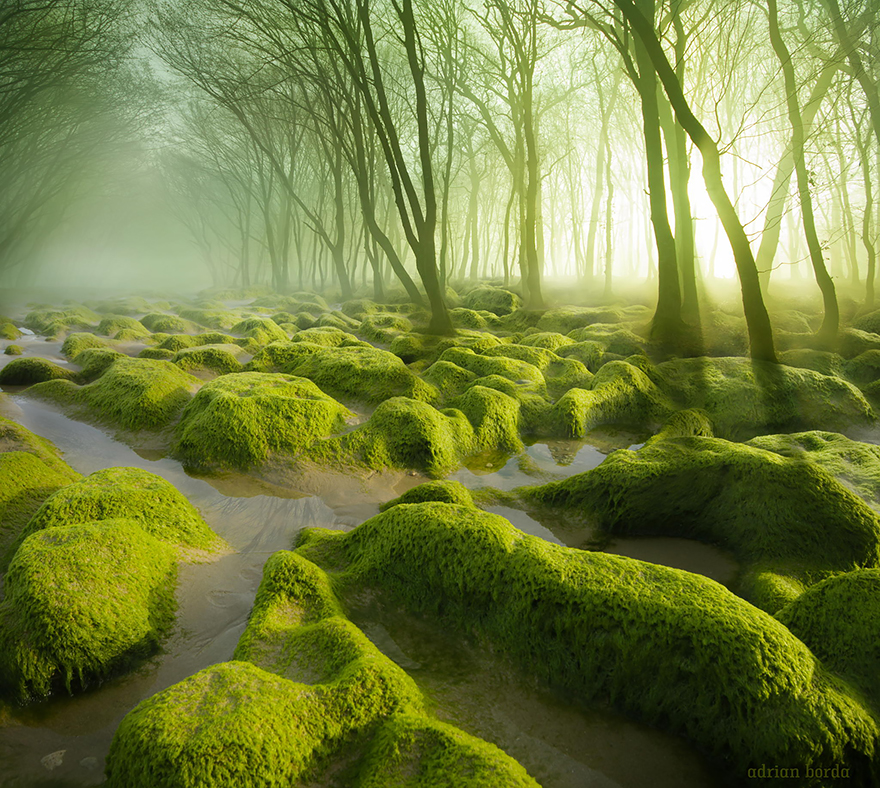
|
| source |
| This moss swamp differs from anything you have ever seen before. The thick blankets of rich green moss completely swallows the rocks beneath them, giving this vivacious swamp its unique appearance. |
| 2) Sunrise Over The Ceahlău Massif |
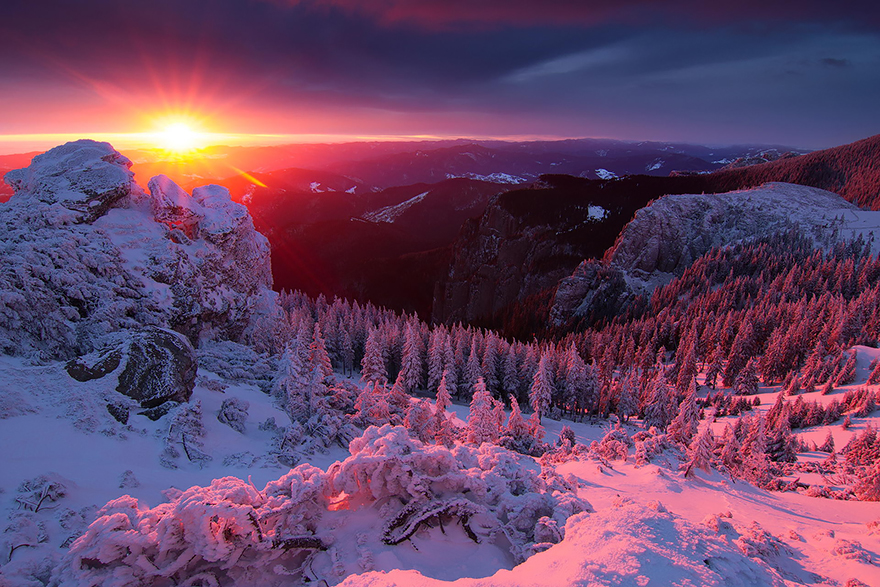
|
| source |
| The Ceahlău Massif belongs to the Bistriţa Mountains of the Eastern Carpathians, and fall into the Moldova region. The Ceahlău Massif is often referred to as the mountain of many legends, involving gods and worship. The elevation at the top is approximately 6,257 feet or (1,907 meters). |
| 3) Sundown at The Sunflower Fields |
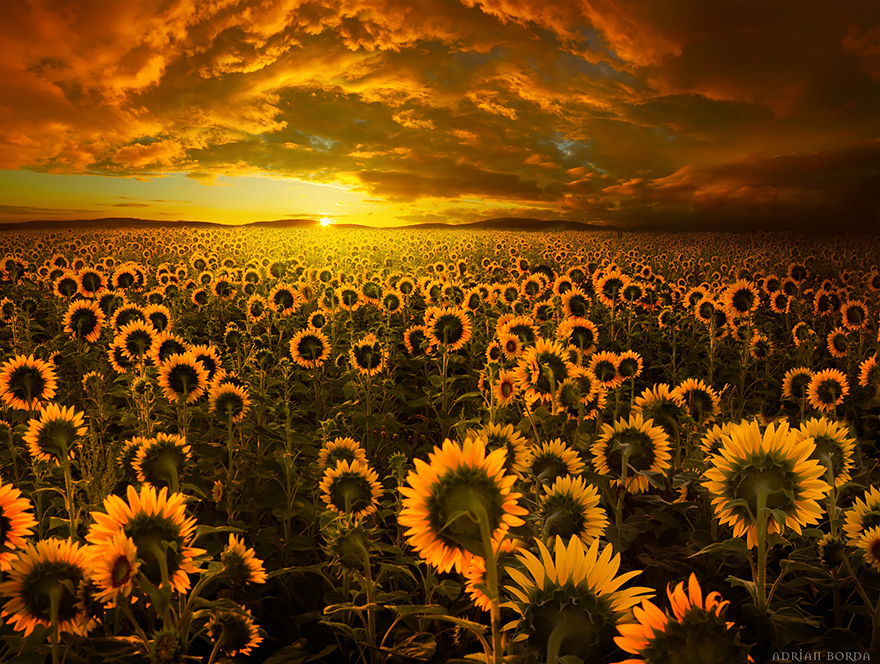
|
| source |
| This magnificent image of a sunflower field, captures a breathtaking view of the sun slowly setting into place. Sunflowers are responsible for producing sunflower seeds, which make for a very healthy snack. Sunflowers can grow taller than six feet as well. |
| 4) Natural Shower at Bigar Waterfall |
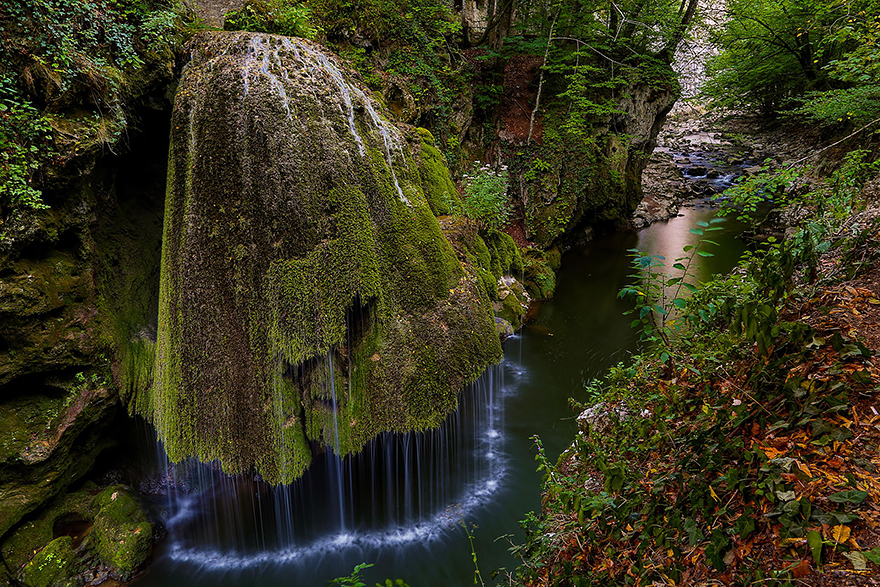 |
| source |
| The Bigar Waterfall, also known as the Izvorul Bigăr, is based in the southwestern Romanian territory of Bozovici. It is approximately 176.60 hectares or (436.4 acres). The Bigar Waterfall is ranked first among eight unique waterfalls around the world. |
| 5) The Long and Winding Transfăgărășan Roads |
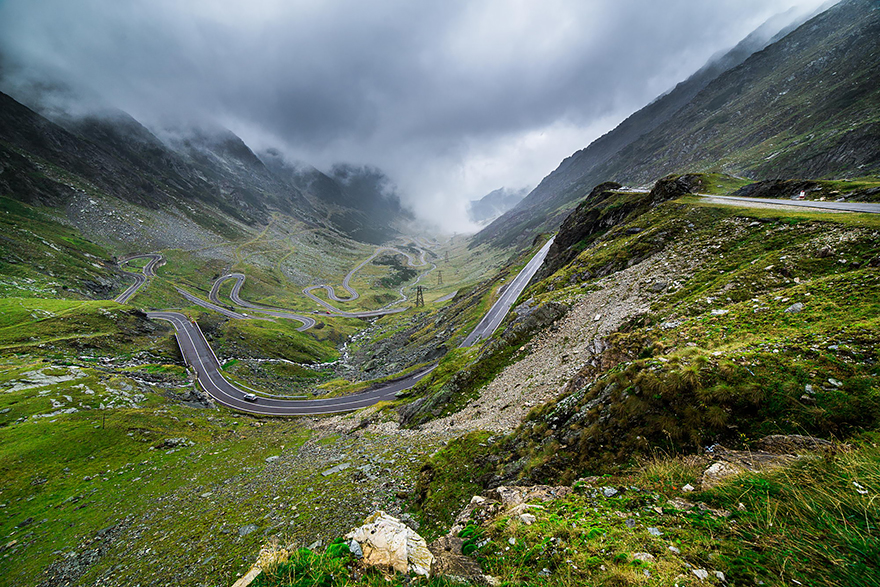 |
| source |
| The Transfăgărășan was built in 1974, and originally constructed as a strategic military route. The road begins near the village of Bascov, and extends to the utmost peaks of the Southern Carpathians, stretching for 60 miles or (90 kilometers). The roads are also crossed by flocks of sheep, which can be seen below. |
| source |
| 6) Magical Sunrise Over The Rodna Mountains |

|
| source |
| The Rodna Mountains are based in Maramureş region of Northern Romanian, near the village of Rodna Veche. The mountains make for perfect hiking trips and ideal skiing resorts. The thick golden smog in the image below adds a mystical touch to the gorgeous Rodna Mountains. |
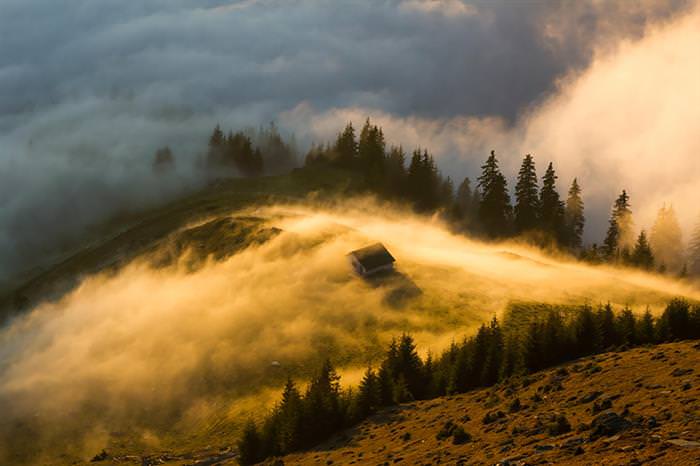
|
| source |
| 7) Summer Afternoon in The Village Biertan |
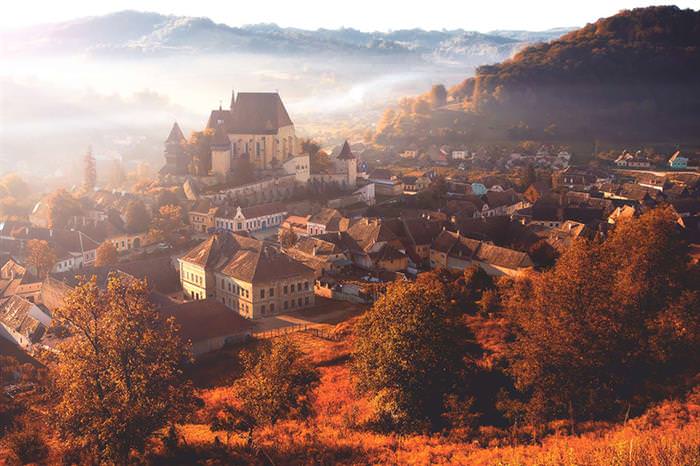
|
| source |
| Biertan is a small commune based just north of the Sibiu County, and renowned for its fortified church, which dates as far back as to the 13th century. The church belongs to the UNESCO World Heritage Sites, and hosts The “Luna Plină” Horror and Fantasy Film Festival. |
| 8) The Contrast of Darkness and Light At Bucegi Mountains |
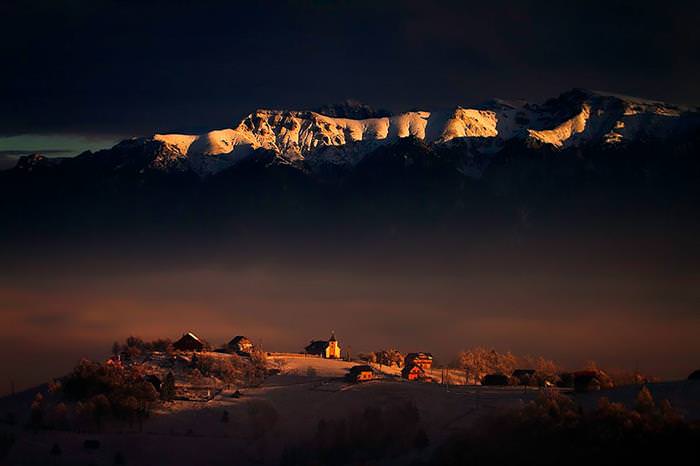
|
| source |
| The Bucegi Mountains are located in the central Romanian city of Brașov. The mountains are divided into three ranges, which includes the Bucegi Mountains, Piatra Craiului Mountains, and the Leaota Mountains. It was even rumored that the God Zalmoxis once lived in a cave on the Bucegi Mountains. Judging by the views, who could blame him! |
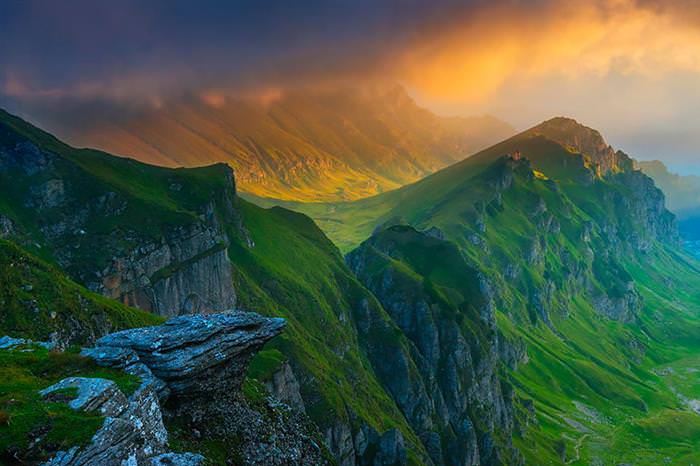
|
| source |
| 9) A New Day At Corvin Castle |
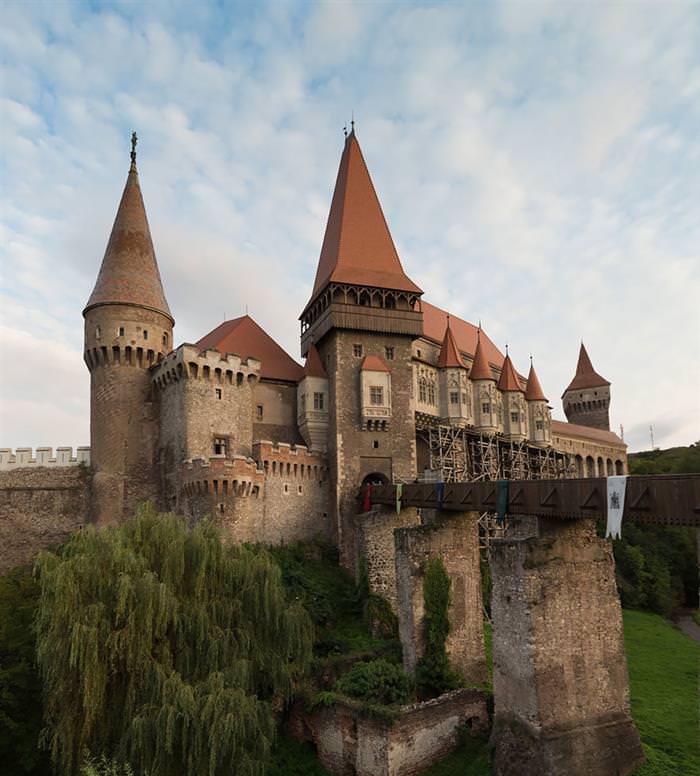
|
| source |
| This legendary Gothic-Renaissance castle once held the notorious Vlad the Impaler as prisoner, under the direct supervision of John Hunyad, who was Voivode of Transylvania or (highest-ranking official in Transylvania). The castle was built in 1446, and is also known as Hunyad Castle or Hunedoara Castle. |
| 10) Wintertime Bliss at Peleș Castle |
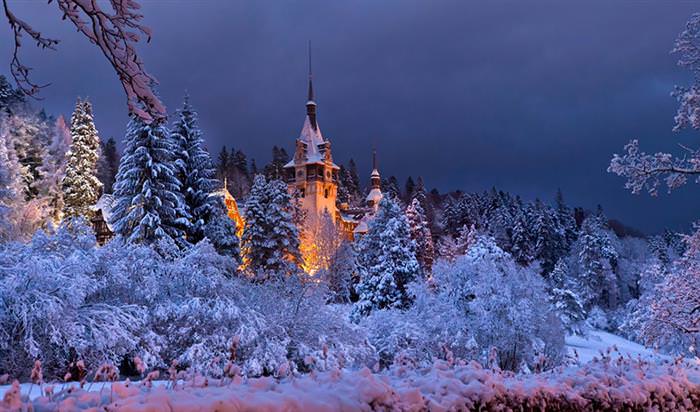
|
| source |
| Peleș Castle was completed in 1914, and has an enormous floor plan with over 170 rooms, and 34,000 square feet or (3,200 square meters). Guided tours of the castle allow visitors to view the incredible museum, which hosts one of the finest art collections in Eastern Europe. Each room offers a treasured set of Romanian history to admire. |
| 11) The Romanian Tunnel of Love |
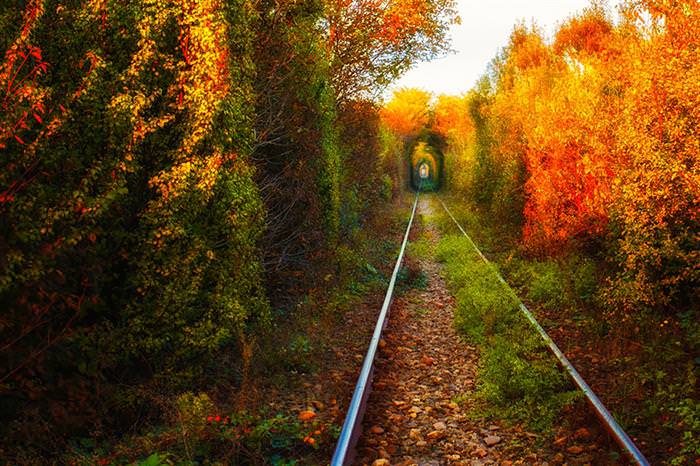
|
| source |
| The Tunnel of Love is an abandoned railway that is found between the cities of Otelu Rosu and Caransebe. Access to the tunnel is through a dirt road located between the two villages. The Tunnel of Love is a must-see place for couples. |
| 12) Rock Sculpture of Decebalus |
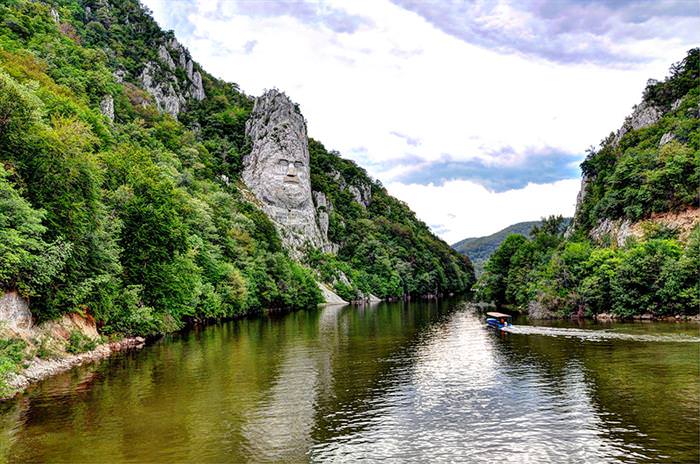
|
| source |
| This magnificent rock sculpture is located near the city of Orşova, and was built as tribute to Decebalus, the last king of Dacia. The sculpture is significant because it marked a huge victory of independence for Romania against the Roman Empire. |
| 13) Snow Covered Mountains of Bran Castle |
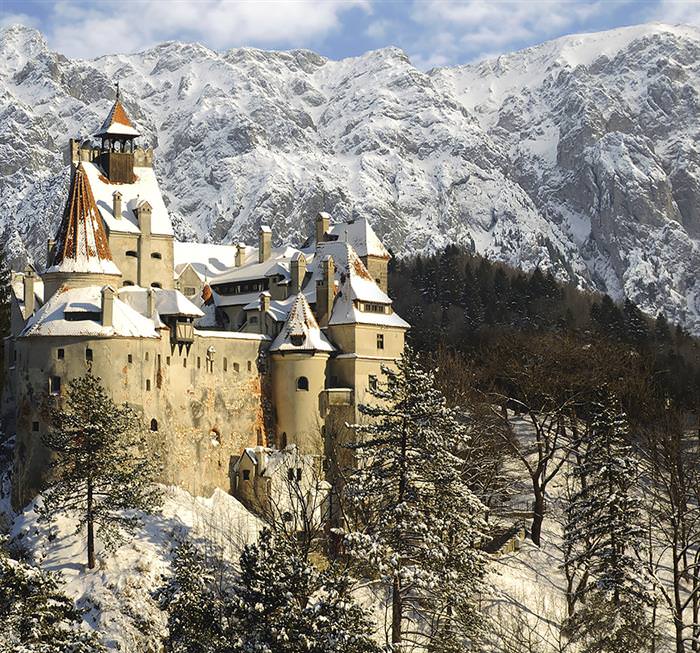
|
| source |
| Bran Castle is the eery castle more infamously referred to as Dracula’s Castle. Despite the grim name, Bran Castle was not frequented very often by Vlad The Impaler, contrary to popular belief. Bran Castle is situated near Braşov, and offers a spectacular view of the countryside. Bran Castle is used as a popular museum attraction for tourists today. |
| 14) Rising Fog Over The Maramureș |
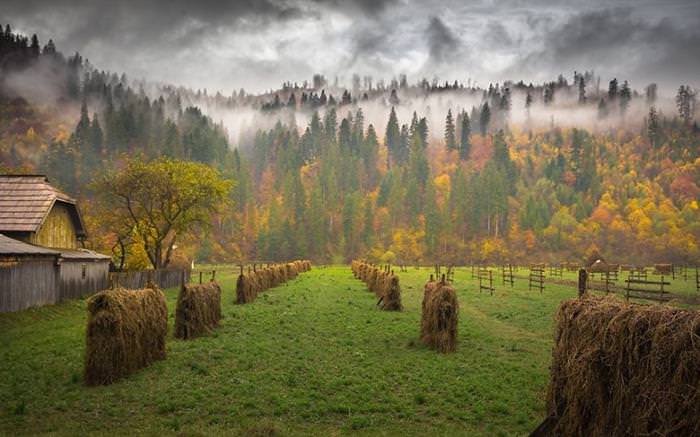
|
| source |
| The Maramureș is a vast geographical region that is located by the upper Tisa River, and extends all the way into western Ukraine. The Maramureș is famous for its wooden churches and historical museums. The forests are home to many protected species of animals and plants. |
| 15) Thin Fog Traveling Through The Apuseni Mountains |
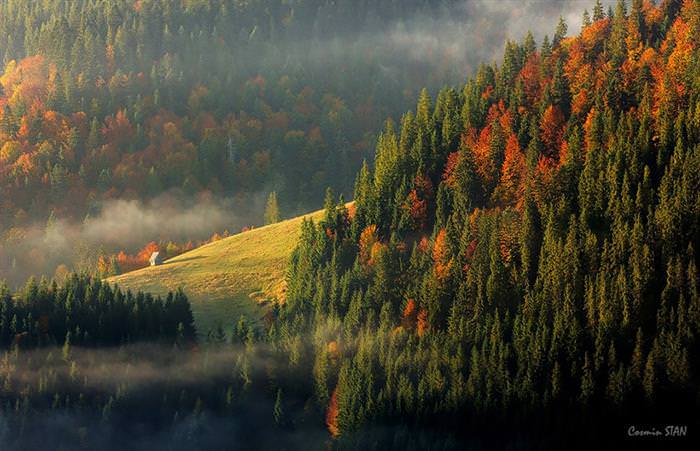
|
| source |
| The Apuseni Mountains are located in Western Romanian Carpathians region of Transylvania. The Romanian translation for Apuseni means “of the sunset”. The highest peak is Bihorul Peak or Cucurbăta Mare, which stands over 6,066 feet or (1,849 meters). |
| 16) The Picturesque Hills of Holbav Village |

|
| source |
| A sheepherder is seen gathering up his flock for a daily journey through the stunning hills of Holbov Village. Holbav Village is situated in Braşov County. It was once part of the Vulcan Commune until its separation in 2004. |
| 17) Picture Perfect Day At Retezat National Park |

|
| source |
| Retezat National Park belongs to the Seven Natural Wonders of Romania. The colorful scenery here is something straight out of a canvas painting. The park is a protected area, and was once featured in the Man and Biosphere Program of UNESCO. |
| 18) The Wide Green Countryside of Brașov |

|
| source |
| Brașov is home to the black church, which is a famous Romanian landmark, and considered to be the largest Gothic style church in Southeastern Europe. Brașov also hosts the Golden Stag International Music Festival, and is the birthplace for the Romanian national anthem. |
| 19) A Snowy Day in Burzenland |
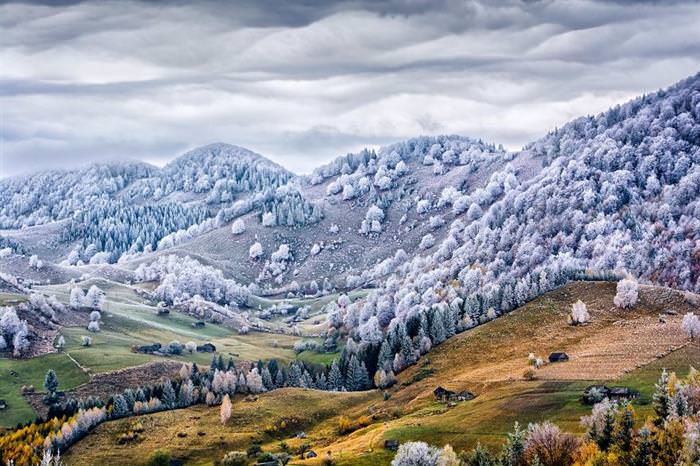
|
| source |
| Burzenland is more commonly referred to as Țara Bârsei, was named after the Bârsa stream. Burzenland is based in the southeastern region of Transylvania, with a rich history that dates back to the early 12th century. |
| (H/T: boredpanda.com)Source: ba-bamail |
The rural town of Savarsin, located 87 kilometers from the city of Arad and almost the same distance from the city of Deva on National Highway 7, lies at the foot of Metaliferi Mountains, where they join the Mures riverside.

Photo credit: (c) CONSTANTIN DUMA/ AGERPRES ARCHIVE
A medium-sized community of 3,290 locals according to the last census, Savarsin is nevertheless famous thanks to the Castle belonging to the Romanian Royal House. It lies near the entry to the rural town when coming from Deva and is located in the middle of a wonderful dendrology park.

Photo credit: (c) IOAN WEISL/ AGERPRES ARCHIVE
“For Savarsin locals, it is a special feeling that they are village fellows, if one may say so, with King Michael I and with the other members of the Royal House”, said rural town mayor Ioan Vodicean, who proudly calls himself ‘The King’s Mayor’.
He explained that the first record of the name of Zawasyn dates back to 1479, in a chancellery transcription of a royal notary. After the end of the Ottoman rule (1699), a salt office was set up in the area and after 1718, the year when the region of Banat was annexed to the Austrian-Hungarian Empire, the community that will be later named Savarsin was bestowed the rank of a market town (oppidum), thanks to the economic development and the surge in the number of locals.
Vodicean explained that in mid-18th century, at the center of the estate on which the current Royal Castle lies, there was a building raised in western baroque style (dating from 1680), that belonged to the local lord named Edelspacher.
The rural town gets the name of Soborszin in 1760 (from the Hungarian words soo — salt, bor — wine, szin — barn).
After having been set on fire in November 1784 by the peasants in the uprise led by Horia, Closca and Crisan, and needed being restored from the foundations, the castle had various owners, till 1858 when it became the possession of Leopold Nadasdy, the one who re-built it in its present form in 1860.
It was Leopold Nadasdy as well who built a clever system of underground networks for the collection of the underground waters and springs and brought a specialist to rearrange the park, which was finalised in 1876; the estate then covered around 500 hectares, most of it being forests.
In 1941, following an exchange of properties, the Castle becomes the property of Mocioni — Starcea family, who prepared the Castle for “Crown weekends”; in 1943, the Castle became the property of King Michael I, who was the king of Romania at that time.
After the communist-era nationalization, Savarsin Castle successively was a hospital of internal diseases, a tuberculosis sanatorium and nervous disorders sanatorium and in 1967 communist dictator Nicolae Ceausescu decided to turn it into a Guest House — a residence for heads of state, allotting more than 50 million lei for capital repair. Nevertheless, in spite of the huge spending and investments into the Castle, Ceausescu visited it only twice — in 1969 and 1979.

Photo credit: (c) CONSTANTIN DUMA/ AGERPRES ARCHIVE
After the 1989 Revolution, Savarsin Castle together with the surrounding park covering a total 16 hectares was turned to the Public Company for the Administration of the State Protocol Patrimony, which did everything it could to maintain it.
In the ensuing years, the Castle became one of the most interesting tourist attractions of Arad county. Those willing to spend a night in the Ceausescu’s bedroom could do so, since the Castle offered excellent accommodation in seven studios and three suites; festive dinners could also be organized.

Photo credit: (c) CONSTANTIN DUMA/ AGERPRES ARCHIVE

Photo credit: (c) CONSTANTIN DUMA/ AGERPRES ARCHIVE
Since 2001, after Savarsin Castle was returned to King Michael, the Castle can no longer be visited, but only admired by the tourists from a distance. Yet, on certain occasions, the Royal Estate gates open wide and the beautiful building can be seen from a closer distance.

Photo credit: (c) CONSTANTIN DUMA/ AGERPRES ARCHIVE

Photo credit: (c) IOAN WEISL/ AGERPRES ARCHIVE

Photo credit: (c) IOAN WEISL/ AGERPRES ARCHIVE
“Traditionally, the Royal Family spends the Winter Holidays at Savarsin, on which occasion many groups come to sing carols to the former sovereign. The carol singers come from the nearby villages, but also from other communities in Arad county as well as from the counties of Alba, Hunedoara and Timis. Also, on Christmas Day, the family members use to take part in the religious service at the Orthodox church in Savarsin. Also at Christmas, the Royal Family members offer gifts to needy families in this rural town. Another occasion on which the Castle gates open is the awards festivity of Dorel Sibii National Literature Festival held at Savarsin every year”, mayor Ioan Vodicean said.AGERPRES
The old fairs of the Crisana Land, mentioned as far back as the 12th century, have played an important part in the development of local commercial exchanges. Most of them have disappeared, some of them have been preserved, almost unchanged – including the Thursday fair at Bins (Beius) and the fair at Vama Sarii (Salt Customs) at Vadul Crisului, today just an occasion to remember the rafts that once would bring down on the Cris rivers salt from the large salt mines of Transylvania, heading them west. Other fairs, such as the Fair of Romanian Folk Masters have emerged and are held each year care of the dedication of specialists.

Photo credit: (c) EUGENIA PASCA/AGERPRES STREAM
‘It is said that exchanging things is as old as the history of the humankind, just that its manifestation has been different from one society to another. The more economically developed a society, the better put together exchange relations are. An important part in the development of yesteryear as well as today’s exchanges has been played by fairs,’ Ph.D. Aurel Chiriac, an art critic and director of the Cris Land Museum Compound (MTC) Aurel Chiriac tells AGERPRES.
What set neatly apart fairs from the daily marketplaces in urban areas is that the former are held less often, just in some periods of time, with yearly or monthly frequency, subsequently known as weekly or annual fairs. Their past frequency, as gatherings out of the ordinary, was most often than not determined by cultural or spiritual events with impact on an area or community, on holidays, religious feasts, or by economic priorities of community interests conditioned by certain stages in agricultural works, animal farming. That explains why besides the seasonal fairs (spring, summer, autumn and winter fairs) or important religious feasts (St. Peter, St. Elijah, St. Dmitry, St. Nicholas) there were fairs at reaping or harvesting times or when sheep were shorn (to facilitate trade in specific products or get the farm hands needed for seasonal agricultural works).

‘We can mention to the point the example of the Beius fair, the Sangeorz fair of ?little servants,’ the ?reaping fair’ at Sampetru, where servants were hired for harvesting spring crops and setting up herds and reaping wheat. Such events, particularly those in mountain areas with a sparse population, were an occasion for people to get to know each other, to socialise and party, especially for young people, where personal relations would bud that would led to marriages,’ said Chiriac.

Although the main aim of the fairs in the Crisana area, for instance the fair at Lespezi — which last edition was held in 1830, the fairs at Calineasa, Halmagiu and Gaina Mountain was commercial exchanges among the people of the nearby areas, mostly related to their sheepherding or crafts making occupations, they were also known for their matrimonial valences as well. The maiden fair on Gaina Mountain and the wife-kissing fair at Halmagiu are famous fairs. Because of such traits — the wife-kissing fair at Halmagiu related to the shepherds kissing their wives goodbye for the time they would go up in the mountains with the sheep, while the fair on Gaina Mountain, with a great local impact, was seen also as a good opportunity for the marriageable girls’ dowries to be exhibited — they have gone down in the locals’ memory for their initial significance.
Fair holding in these areas was mentioned very early. As far back as the 12th century, the Saniob Monastery was allowed to hold trade fairs in the village near the church, a right that was later on awarded to more settlements: Oradea, Cheresig, Cefa, Ianosda, Targusor (Bihor County), Carei (Satu Mare County), Simand (Arad County).
Demographic increase, the development of the means of production and increasingly more important occupational specialisation generated in their turn an intensification in trade and implicitly an increase in the number of trade fairs.
Starting with the 18th century, the operation of such fairs was also mentioned at Marghita, Sacuieni, Diosig, Gyula, Debretin, Tileagd, Alesd, Cefa, Salonta, Beius, Beliu, Vascau, Dezna, Ineu, Zarand, Chisineu-Cris and Buteni.

Today, besides those fairs, others emerged for other reasons. One of them is the Trade Fair of Romanian Masters, a three-day event in Oradea, in the closest weekend to the feast of St. Elijah (July 20). The reason for its establishment was the promotion of genuine high-quality craftspeople work and reviving crafts by providing support for the craftspeople to sell their products.
The Trade Fair of Romanian Masters was first held in 1994 at the initiative of some lovers of folk products — MTC Director Aurel Chiriac and ethnographer Craciun Parasca, a councillor with the Bihor County Culture Directorate — with logistic and human support from the Ethnography Department of MTC.

‘Irrespective of their development and organisation, fairs are still the most natural ways for supply and demand to meet, where negotiations and the conclusion of trade still follow traditional ways, such as shaking hands, being an oasis with many particular features amidst a world that is increasingly more globalised. And the traditional arts we want to support in their most genuine forms, deserve all our efforts,’ said Chiriac.
He mentioned that nearly 10 years ago a draft law was drawn up for the statutes of folk masters designed in Oradea by him and ethnographer Parasca that got stuck with the Senate.
The masters themselves have acknowledged that the Oradea fair is the most profitable for them because, since it is held once a year, the people of Oradea appreciating genuine products anxiously wait for it. For that reason, competition to get in the fair is high. More than 10,000 Oradea people visit the stalls of the exhibiting craftspeople.
The first edition of the Trade Fair of Romanian Masters attracted 53 exhibitors that displayed products from the most important areas of folk creation: wood and leather processing, wicker works, wooden and glass icons, naive art, musical instruments, masks, pottery, painted eggs, folk costumes and countryside textiles.

Because of the seriousness of the principles underpinning the organisation of the fair, the number of exhibiting craftspeople has increased continually, from 70 in 1995, to 120 in 2014. In the next two decades, the number of exhibitors will increase along with the number of folk creation areas, organisers say.
Their care has always been bringing in novelties to the fair that relate to very old crafts, such as a shoemaker at the 2014 edition who makes shoes just like in the times of the ancestors, and a glassware master at the 2012 edition who stands for what once was a traditional occupation in Bihor area that was lost in the meantime.
The range of creation areas has expanded from one year to the other. While in 1994 there were 10 areas of crafts, in 2013 they increased to 17. Besides the ones mentioned above, there were some new ones, such as bone and metal processing, countryside ornaments, medicinal herbs, glass processing and gingerbread making.
Representativeness of the national area covered by the participants in the fair has increased from one edition to the other. While the 53 craft masters in the first edition came from 16 of Romania’s 41 counties, Bihor County included, the 120 participants in the 2014 edition came from 35 counties, 26 of them from Bihor County.

‘All the important ethnographic areas of Romania have at least one representative taking part in the event in Oradea,’ Chiriac underscores.
Out of the desire to give an international aspect to the fair of folk masters, the Cris Land Museum has since 2003 invited folk masters from Hungary (which number increased from four in 2013 to seven in 2014), one from Moldova in 1995, one from Serbia in 2014 and even one from Cameroon in 2013 and 2014.

Photo credit: (c) PAUL BUCIUTA/AGERPRES ARCHIVE
The objects crafted by the folk masters get to the homes of Bihor people, as well as to the ethnographic heritage of the museum, which has put together a collection of nearly 10,000 items of contemporary folk arts for the future generations to see. AGERPRES
The Padis tourist area, in the Bihor Mountains, situated in the Apuseni Natural Park draws thousands of tourists annually. The grandiose karstic shapes, located both at its surface and deep down, pristine in Romania, culminate through the Cetatile Ponorului complex. In a great variety of natural tourist objectives, most of them natural reserves, specific to this area are the famous ice caves or the towering Cheile Galbenei (Gorges of Galbena) or the Somesul Cald (Warm Somes).

Photo credit: (c) Eugenia Pasca / AGERPRES
‘With several unique, gorgeous things, protected in zones of special preservation, Padis is sheltering on almost 25 square kilometres the biggest density of reserves and monuments of Apuseni. Naturally this is a reason of pride for the Bihor citizens and Romanians in general, because they are representative at European level through the natural potential they have at hand,’ professor Lucian Nistor, technical director with the County Rescue Salvamont Service — Salvaspeo Bihor told Agerpres.
In his opinion, tourism in such an area should be conceived through three characteristics: ecological, economic and educational. As karstic phenomena, says he, they are the most impressive of Romania, but as they have a natural park status, and not a national park one, which excludes any human intervention, a more favourable symbiosis is requested of the environment with the local community.

‘The need of the nature and the need of the community should be both considered. Although the forest was exploited from ancient times, naturally — otherwise it dies, here, unfortunately it is exploited without wisdom, in an exaggerated way, both against the natural regeneration potential of the forest and against the reforestation activities. This is the aspect noticed in Padis. Yet what tourism can one perform if one has no accommodation?’ Nistor said.

The first step for the Padis tourism was the county road’s rehabilitation connecting it with the DN 76 Oradea-Deva, close to Beius. The 29 km were asphalt-covered by the Bihor County Council, for this major tourist project through a 76 million lei European financing. The road was completed in 2012.
Although the access to Padis is feasible on a “like in the palm” road, up there, on the mountain lack the accommodation infrastructure and facilities for now. There exist only three half boards under construction, remained at red brick stage. Here, in this area the construction is allowed, yet special approvals should be obtained to prevent the special conservation areas. Such areas are several, as Poiana Ponor or the oligotrophic bogs.
Tourists could stroll, by foot, the Catatile Ponorului, Cheile Galbenei, Cetatile Radesei circuits or the Lumea pierduta (The lost world) trail where the mountain fans could discover karstic valleys, sinks, karstic close depression, Poiana Ponor, caves and potholes, cascades.

In the Padis area, the deepest cave in Romania exists, the Valea Rea cave, at minus 600 metres depth, with an up to 800-metre potential.
The most visited, unarranged from the tourist point of view cave is the Cetatile Ponorului karstic complex, with the highest gateway in Europe, 120 metres. The underground side is not included in the tourist tour, as it is reserved only to the amateur and professional speleologists with certain training.

The wild Cheile Galbenei, with their famous tunnel, its fan-like cascade and even the gorges themselves are of a remarkable complexity and grandeur. The Catatile Radesei is an old cave, a true geological laboratory, in the last evolutionary phase of a cave, following that within a few thousands of years, should the man doesn’t accelerate this process, the cave would transform itself in a gorge, experts say.
The Padis Plateau, of a rare beauty still just a little touched by the anthropic influence is famous through its characteristic micro-climate through a so-called Padis-fog which forms itself in the warm period of the year, a phenomenon studied by meteorologists and climatologists, which confer a certain magic to the area.
Mandatory, in Padis one should remind the five ice caves of Romania: Scarisoara, Barsa, Focul Viu (Living Fire), Zapodie and Avenul Negru (The Black Ravine). They could be visited but, unfortunately the ice volume diminishes year-by-year, in front of a not so encouraging perspective that within a few years the ice will disappear, especially in the Zapodie and Barsa caves.

“We cannot cut tourism, we cannot protect the environment but trying to protect it actively. To shut down an area is both an utopia and counter-productive, it is easier to control it than impose it by force. From my viewpoint, the creation of the Natural Park of Apuseni including areas from three counties is beneficial, but this body should enforce its rules in order to control the tourist flow, to make an ecological education, to establish certain regulations and least but not last to set up the punitive means,’ the mountain rescuer said.
As regards the tourist routes, the Salvamont Service technical director says everything that means tourist marking was being restructured and aligned with the European norms. From a tourist artery, with a red belt crossing the Oriental Carpathians from North to South, tourist routes were opened or re-arranged to the main tourist objectives in the area, yet in order to cut the anthropic impact all of those are circuits. The Padis is connected through a red belt with the artery which starts from the Vladeasa Mts, and passes through the Stana de Vale, then through the Padis, Glavoi, Vartop, the Bihorul Mare Peak and the Gaina Mt.
All Padis circuits are marked and approved in accordance with the procedure issued by the Tourism Ministry. Each route has its own file and it corresponds entirely to the legal norms.
For the tourists’ security, the mountain rescuers have made technical safety arrangements in the area. So, in the gateway of the Cetatile Ponorului, on the access trail steps and a cable were put for the tourists to help themselves when climbing up or down. Other technical arrangements are in the third sink, on the Galbenei Gorges with balustrades, in the Cetatile Radesei — a cable, steps and chains, and in the Vartop area, the rescuers have participated in arranging a via-ferrata route in the Pietrele Negre area.

Accomodation in Padis with tents, is only agreed in places especially dedicated, meaning around the Padis cottage and in the area of the Glavoi clearing; in the rest, camping is forbidden. The Apuseni Natural Park Administration has itself rangers as employees in this respect. The Salvamont Service ensures the preventive patrol and first-aid granting through its fixed permanent posts at Stana de Vale, Poiana Glavoi and Vartop. The Salvamont Service could be appealed at 112 emergency number or at the national dispatcher, calling 0 Salvamont.
‘The mountain hikes have recreational, spiritual and of physical nature features, meaning movement, which is so necessary to the modern mankind. Let’s not forget that this area of Apuseni of maximum landscape and cultural value should be known, appreciated and protected in a beneficial communion both to the man and to the Mother Nature,’ Lucian Nistor highlighted. AGERPRES
The largest year-round spa resort in Romania, Baile Felix (Felix Spa) emerged and developed around the oldest baths known in the country.

Photographies by Eugenia PASCA / AGERPRES PHOTO
A local legend has it that by around 1095, King Ladislaw himself, while travelling through these lands allegedly discovered the thermal therapeutic springs. The oldest witness to the existence of the baths dates from 1221, from the time of Hevius de Magno-Varadina Abbey, that lasted in these places till the Turks. The name of Felix is supposed to come from the monk who discovered the beneficial effect of the very warm water springing from the ground.
Thanks to the thermal waters, Felix spa and its ?little sister’, 1 Mai saw tourists flocking to visit them in the second half of the 19th century, thus becoming a new highly sought for therapeutic place. In recognition of its therapeutic qualities, the thermal waters in this area were awarded the gold medal and the honorary diploma at the World Exhibition in Paris, in 1896.
The first treatment facilities were built in mid-last century. Today, the nearly 30-hectare Felix Spa hosts eight big hotels, guest houses and smaller hotels, holiday villas, a medical recuperation hospital and a host of outside pools.
Baile Felix mineral waters have a temperature between 40-49 degrees Celsius when springing from the ground and the salt concentration of a little over one gram per litre offers the waters miraculous properties for most diseases of the muscle-skeletal system, degenerative and inflammatory diseases, as well as partial paralysis, paralysis, post-traumatic recuperation, neurological diseases (slipped disc etc.).
Felix Wellness&Spa lies eight kilometres from the city of Oradea, in an area covered by oak and beech forests, in a moderate continental climate specific of the plain and hills, with warm summers and mild winters. Under the influence of the Mediterranean-origin elements, Baile Felix is a most fit destination for holidays, leisure, entertainment and treatment as well as for business events.
Starting 1995, the largest share in the technical-material base of Baile Felix resort has been held by SC Turism Felix SA, the most experienced and largest player in the Romanian spa&wellness tourism. The eight hotels in the company’s portfolio offer conditions ranging from two—to four-stars and will soon offer five-star facilities. Nearly 2,500 accommodation places are available and the services are provided by 700 personnel, specialised medical staff and dedicated and professional therapists.

Aware of the tourists’ needs and increasing demands, SC Turism Felix SA is conducting a major investment plan. Thus, in spring the resort will be able to boast the opening of Lotus Therm Hotel, the only five-star thermal complex in Romania, which is billed to be the jewel in the crown of Felix Spa and an international point of attraction, the company managers say.

‘The new hotel will be quite spectacular and will be a modern architectural objective, the novelty of which will be the removable glass dome covering the indoor pools. The hotel will have conference rooms, restaurant-lounges, a state-of-the-art Wellness&Spa centre, a treatment centre with all the equipment one can wish for, 14 indoor and outdoor swimming pools with re-circulation and thermal and thermal-mineral water, and, of course, accommodation in single, double rooms and suites’, SC Turism Felix SA managing director Florin Serac told AGERPRES.
Baile Felix is a dynamic resort, with garden restaurants, shops and a bazaar. At night, the tourists may enjoy traditional Romanian parties and in summer, the swimming pools are seeing quite a buzz thanks to aqua-zumba, aqua-fitness and foam and DJ parties, games for children, volleyball and football. The forest surrounding the resort is the ideal spot for the sport fans, for horse-riding, paintball, mountain-biking, trail running or merely walking.
A major attraction is offered by the lake covered in water lilies in central resort. It is a thermal lake where the India Lotus and the White Water Lily (Nymphaea alba) grow and flower in the warm season.

Apollo-Felix swimming pool is the most modern thermal aquatic complex in western Romania and is open year-round, having been completely rehabilitated in 2008; it is the only one in Romania having a wave pool. It boasts ten thermal water pools, two of them for children.

The stateliest building so far, Hotel International, a four-star unit is the only hotel in Romania having been awarded the EUROPESPA-med excellence certificate given by the Brussels-based European Spas Association (ESPA). It certifies the fulfilment of the standards relating the general infrastructure of therapies, hygiene and the tourists’ security. It re-opened in 2007 after extensive upgrading and starting this year it offers a saline facility with enhanced effects — a 50-minute session here equals three to four hours spent in an usual salt mine.
The athletes prefer the two-star hotels Poienita and Mures thanks to the facilities they offer and the impressive recuperation treatment base. The professional running trail in the forest near the resort is seeing various Romanian national teams training every year. Former Olympian and world running champion Gabriela Szabo, today a Minister of Youth and Sport ran thousands of kilometres on the forest trails around the resort.

Only two kilometres away lies Baile 1 Mai spa with Venus Swimming Pool, located in a green area and impressive by the special architecture and the arrangement of the swimming pools in the form of a lotus flower. The tourists may relax here in one of the 13 pools, ranging from the diving pool to the children’s pools and thermal pools. The old Bishopric Baths in 1 Mai still shelter the renowned thermal water lily Nymphaea lotus, breed thermalist that had been declared a natural monument as far back as in 1931.

Also operating in Baile Felix spa is the Medical Recuperation Clinical Hospital set up in 1988 on an initiative of the local authorities.

A multi-discipline team headed by medical doctors specialising in recuperation and physical medicine is conducting such activities as medical assistance, research and education in medical recuperation and organises annual scientific events, either regional or national, meant to promote the medical recuperation specialisation as well as the natural healing factors that Baile Felix benefits from.AGERPRES
Padurea Craiului Mountains in the south-eastern part of Bihor County have often been compared to Switzerland, but not because their peaks would rival the tall peaks of the Alps, but because their wild landscapes and caves are breathtakingly beautiful.

Photo credit: (c) EUGENIA PASCA / AGERPRES ARCHIVE
The smooth slopes of the Apuseni Moutains conceal steep gorges dug deep into rocks by streams that for millennia have been seeking their way to the Cris rivers. The Lazurilor and the Cutii canyons are worthy places for everyone calling themselves nature lovers.
‘Padurea Craiului [literally,the King’s Forest] is caught like a ribbon between the Crisul Negru to the south and Crisul Repede to the north. One of the most sought after areas is related to the Crisul Repede. From Bratca to Vadu Crisului, the river crosses a series of canyons which steep walls have been modelled into stupendous caves by streams long lost in karsts. Eagles are the only masters of the skies above,’ says Florin Budea, an official of the Bihor Centre for Protected Areas and Sustainable Development (CAPDD).
Bihor County houses the largest number of caves planned for tourists in Romania gathered in a network that comprises Ursilor Cave (Bears’ Cave), Meziad Cave, Vadu Crisului Cave, Ungurului Cave (Hungarian’s Cave), the crystal cave at the Farcu mine, with 20 more being currently planned for the same purpose.

The Vantului Cave (Wind’s Cave), the longest underground labyrinth in Romania, stretches over several levels is yet to be fully known, after more than 45 km of its galleries have been mapped.
Much more visible and accessible to adventure seekers, the Ungurul Mare Cave (Big Hungarian Cave), the Vadu Crisului Cave and the Zmaului Cave (Dragon’s Cave) have preserved memories of various historical eras that left their imprints on the realm.

In the Ungurul Mare Cave objects and pieces of pottery vessels going back to the Dacian times have been found.
The Vadu Crisului Cave is one of the first planned caves in Romania. In the early 20th century, a Magyar nobleman, owner of large swathes of land, built here a pontoon for the boats that were floating on the underground lake, in the trembling light of torches. A little bit downstream, at the edge of the impressive portal of the Zmaului Cave, the ruins of a lookout tower are still visible. Two or three hundred years ago, customs officers would keep watch over the place and collect tax on the salt shipments going down to the Crisul Repede, coming from Transylvania en route to Oradea.
The Ciur Izbuc Cave is the most precious gem in this priceless string. The earliest traces of the Homo sapiens, the modern prehistoric man, have been found here that a team of Romanian and American scientists has recently said are 37,135 years old. In the Hall of Lost Steps, the traces of a male, a woman and a child walking together, probably members of the same family, were found. Their footsteps are visible even today, the same as traces of cave bears, which bones lie there in underground layers 10-12,000 years old.

Above the majestic rock walls of the canyon, there is a realm that time has almost forgotten. Large forests, isolated villages, patriarchal landscapes and people who seem adamant about living in bygone eras. Damis, Rosia, Remetea and other close villages are places where mass tourism has not reached yet. Accommodation is hard to find because boarding houses are still few, but people are welcoming and peace supreme.

The crystal cave at the Farcu mine is a stone’s throw from the centre of the commune of Rosia. Discovered in the 1980s, during mining works, this cave is the only one in Romania where anyone can discover from a very short distance the beauty of the calcite crystals that are as bright as they are brittle. The cave has been recently planned and besides enjoying maximum safety, tourists can visit an old mining gallery where on display are objects related to underground quarrying. The most daring tourists can take a look down toward the innards of the earth, to an underground pitch that goes down 80 m below the circulation level of the mine. On the outside, tourists can take a long fly on the zip line, above fir tree peaks and the concealed depths of a dale.

For decades, the Meziad Cave was considered to be the biggest cave in Romania. What is really impressive about it is not its length, but the size of its underground galleries. The underground hollows which ceiling is lost in the dark, somewhere 50 metres above soil, have frequently been compared to the interior of a cathedral.
Here the only known underground natural bridge in Romania can be crossed by foot. This highly rare underground formation is the outcome of the collapse of the ceiling of a hall that used to be under another equally large cave. From the bridge in the Meziad Cave to the level of a lower gallery tourists witness a level difference of more than 40 m. Seen from above, the tourist path that crosses the cave leaves an indelible impression on visitors.

Close to the entrance to the Meziad Cave, there is a via-ferrata climbing trail that starts right from below, climbs up a rock wall and ends just above the portal of the immense cave, a portal that is no less impressive than the interior of the cave. Also in this cave, folk rock concerts are staged.
The entire area is a heaven for speleologists. Tens, maybe hundreds of underground hollows, both known and undiscovered, entice the practitioners of this art that has no spectators. While underground worlds are most often than not accessible to tried speleologists only, the beauty of the world outside the caves comes in handy to any tourist wanting to discover it. Recently, two cycle hire centres have been opened. Tourists can use the bikes to move quicker and cleaner around. The two centres, at Rosia and Remetea, were needed because there is a lot to see and do in the area.
At the entrance to the commune of Rosia, a water mill is standing on a homonymous stream, grinding grains for almost two hundred years. Its owner, who is also a guide for the tourists visiting the mill, is also an unrivalled player of a violin-cum-bugle instrument that is specific only to this part of Bihor County.

The picturesque hamlet of Runcuri, above Rosia commune, boasts itself of a group of traditional houses that have been redesigned to provide tourists with the most comfortable accommodation conditions. Houses more than one hundred years old, even a sty, have everything a tired traveller could wish for in terms of accommodation. The beauty of these traditional structures and the environs seem cut off from a fairy tale.
The heritage of the commune of Remetea adds more value to the place where God made the Meziad Cave. An oak tree, more than 400 years old lining the path to the village, is a leftover of the past forests. A small ethnographic museum in the commune describes in its two rooms the traditional life style of Romanians and Hungarians, two communities that have for centuries shared the land and woods here. The church at Remetea, a historical monument, nears a millennial age. The frescoes uncovered below layers of lime reveal a church that originally was Byzantine, then it became Catholic; it shortly served as a place of worship for the conquering Ottomans, ending up a Protestant church.
The cultural riches of the area is rounded up by crafts specific of mountainous areas, such as wood processing, animal farming and sewing of folklore costumes. The ornaments specific of the area are made of coloured glass beads and are called zgardane.
Already a tradition, the Straita Plina (Full Bag) trade fair of traditional wares in mid-October at Rosia is the place where special treats can be tasted and purchased, including pies baked according to local recipes; goat cheese prepared using the most surprising ingredients; chilli pepper and red onion jam, as well as the unforgettable Bihor palinka.

On Easter, the people of Dragoteni will paint eggs, while on the first day of the Nativity fast Christmas carols start being sung, handed down from one generation to the next.
This is just a smidgen of the beauty of this heavenly realm of Bihor County. Anyone wanting to find out more is warmly welcomed to the Padurea Craiului Mountains. AGERPRES